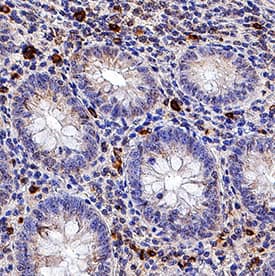Human Nectin-3 Antibody Summary
Leu56-Asp400
Accession # Q9NQS3
Customers also Viewed
Applications
Please Note: Optimal dilutions should be determined by each laboratory for each application. General Protocols are available in the Technical Information section on our website.
Scientific Data
 View Larger
View Larger
Nectin‑3 in Human Kidney Array. Nectin-3 was detected in immersion fixed paraffin-embedded sections of human kidney array using Goat Anti-Human Nectin-3 Antigen Affinity-purified Polyclonal Antibody (Catalog # AF3064) at 10 µg/mL overnight at 4 °C. Tissue was stained using the Anti-Goat HRP-DAB Cell & Tissue Staining Kit (brown; Catalog # CTS008) and counterstained with hematoxylin (blue). View our protocol for Chromogenic IHC Staining of Paraffin-embedded Tissue Sections.
Preparation and Storage
- 12 months from date of receipt, -20 to -70 °C as supplied.
- 1 month, 2 to 8 °C under sterile conditions after reconstitution.
- 6 months, -20 to -70 °C under sterile conditions after reconstitution.
Background: Nectin-3
Nectins are a small family of Ca++-independent immunoglobulin (Ig)-like cell adhesion molecules (CAMs) that organize intercellular junctions (1-4). The Nectin family has at least four members (Nectin-1‑4), all of which show alternate splicing, a transmembrane (TM) region (except for Nectin-1 gamma ), and three extracellular Ig-domains. Nectins are highly homologous to the human receptor for poliovirus, and as such, have been alternatively-named poliovirus receptor-related proteins. They do not, however, appear to bind poliovirus (1). Nectin-3 (also named PRR3, CD113, and PVRL3) is an 83 kDa, type I TM glycoprotein. Its precursor is 549 amino acids (aa) in length. It contains an extended signal sequence of 57 aa, an extracellular domain (ECD) of 347 aa, a transmembrane segment of 21 aa (aa 405-425), and a cytoplasmic region of 124 amino acids. The ECD shows three Ig-like domains; one N-terminal V-type and two membrane-proximal C2-type. The cytoplasmic region shows a Glu-Trp-Tyr-Val motif that binds afadin (3, 5, 6). The ECD of human Nectin-3 is 94% aa identical to mouse Nectin-3 ECD (5, 6). Nectin-3 has a diverse expression pattern. It has been found in junctions between small intestinal columnar epithelial cells (6), pigmented and nonpigmented epithelium in the ciliary body (7), spermatids and Sertoli cells in the seminiferous tubules (8), and on spinal cord motor neurons and axons, plus Schwann cells of the peripheral nervous system (9). As with mouse, human Nectin-3 has three potential isoforms. It does not appear that they are strict orthologs. In addition to the full length isoform, a second human isoform has a 31 aa substitution for the first 54 aa of the signal sequence, followed by a deletion of aa 291-549 (10). The third human isoform shows a 10 aa substitution for aa 357-549 (11). Nectin-3 is proposed to promote cell adhesion by initiating cell-to-cell adhesion, allowing for subsequent JAM and cadherin-based intercellular junction formation. It does so by first forming same cell (cis-) heterodimers with alpha v beta 3 and PDGF R (an anti-apoptotic interaction) (2, 4). This results in actin reorganization and recruitment of adherens and occludins adhesion molecules. Subsequent Nectin-3 activity adds strength to the junction through trans-interactions with a variety of molecules, including Nectin-3 itself, as well as Nectins-1 and 2 plus Necl-1, 2 and 5 (3, 4).
- Takai, Y. and H. Nakanishi (2003) J. Cell Sci. 116:17.
- Miyoshi, J. and Y. Takai (2007) Am. J. Nephrol. 27:590.
- Sakisaka, T. et al. (2007) Curr. Opin. Cell Biol. 19:593.
- Rikitake, Y. and Y. Takai (2008) Cell. Mol. Life Sci. 65:253.
- Reymand, N. et al. (2000) Gene 255:347.
- Satoh-Horikawa, K. et al. (2000) J. Biol. Chem. 275:10291.
- Inagaki, M. et al. (2005) Development 132:1525.
- Inagaki, M. et al. (2006) Genes Cells 11:1125.
- Zelano, J. et al. (2006) Exp. Neurol. 201:461.
- GenBank Accession # BAC11414.
- SwissProt # Q9NQS3.
Product Datasheets
Citations for Human Nectin-3 Antibody
R&D Systems personnel manually curate a database that contains references using R&D Systems products. The data collected includes not only links to publications in PubMed, but also provides information about sample types, species, and experimental conditions.
3
Citations: Showing 1 - 3
Filter your results:
Filter by:
-
Single-cell transcriptomics reveals immune suppression and cell states predictive of patient outcomes in rhabdomyosarcoma
Authors: DeMartino, J;Meister, MT;Visser, LL;Brok, M;Groot Koerkamp, MJA;Wezenaar, AKL;Hiemcke-Jiwa, LS;de Souza, T;Merks, JHM;Rios, AC;Holstege, FCP;Margaritis, T;Drost, J;
Nature communications
Species: Human
Sample Types: Whole Tissue
Applications: IHC -
Designed Ankyrin Repeat Protein (DARPin) Neutralizers of TcdB from Clostridium difficile Ribotype 027
Authors: Z Peng, R Simeon, SB Mitchell, J Zhang, H Feng, Z Chen
mSphere, 2019-10-02;4(5):.
Species: Human
Sample Types: Protein
Applications: ELISA (Capture) -
CADM1 is a key receptor mediating human mast cell adhesion to human lung fibroblasts and airway smooth muscle cells.
Authors: Moiseeva, Elena P, Roach, Katy M, Leyland, Mark L, Bradding, Peter
PLoS ONE, 2013-04-19;8(4):e61579.
Species: Human
Sample Types: Cell Lysates
Applications: Western Blot
FAQs
No product specific FAQs exist for this product, however you may
View all Antibody FAQsReviews for Human Nectin-3 Antibody
Average Rating: 5 (Based on 1 Review)
Have you used Human Nectin-3 Antibody?
Submit a review and receive an Amazon gift card.
$25/€18/£15/$25CAN/¥75 Yuan/¥2500 Yen for a review with an image
$10/€7/£6/$10 CAD/¥70 Yuan/¥1110 Yen for a review without an image
Filter by:


















